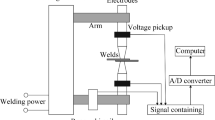Abstract
Real-time estimation of weld quality from process data is one of the key objectives in current weld control systems for resistance spot-welding processes. This task can be alleviated if the weld controller is equipped with a voltage sensor in the secondary circuit. Replacing the goal of quantifying the weld quality in terms of button size by the more modest objective of indirect estimation of the class of the weld, e.g., satisfactory (acceptable, “normal” button size), unsatisfactory (undersized, “cold” welds), and defects (“expulsion”), further improves the feasibility of the mission of indirect estimation of the weld quality. This paper proposes an algorithmic framework based on a linear vector quantization (LVQ) neural network for estimation of the button size class based on a small number of dynamic resistance patterns for cold, normal, and expulsion welds that are collected during the stabilization process. Nugget quality classification by using an LVQ network was tested on two types of controllers; medium-frequency direct current (MFDC) with constant current controller and alternating current (AC) with constant heat controller. In order to reduce the dimensionality of the input data vector, different sets of features are extracted from the dynamic resistance profile and are compared by using power of the test criteria. The results from all of these investigations are very promising and are reported here in detail.
Similar content being viewed by others
References
Denisov AA, Shakarji CM, Lawford BB, Maev RG, Paille JM (2004) Spot weld analysis with 2D ultrasonic arrays. J Res Natl Inst Stand Technol 109(2):233–244
Doyum AB, Sonat M (2003) Ultrasonic examination of resistance spot welds. Journal of Nondestructive Testing (NDT) vol 8, issue 12. Available online at http://www.ndt.net/v08n12.htm)
Lee H-T, Wang M, Maev R, Maeva E (2003) A study on using scanning acoustic microscopy and neural network techniques to evaluate the quality of resistance spot welding. Int J Adv Manuf Technol 22(9–10):727–732
Rooks B (2003) Advances in resistance welding for body-in-white. Assem Autom 23(2):159–162
Chien C-S, Kannatey-Asibu E Jr (2002) Investigation of monitoring systems for resistance spot welding. Weld J 81(9):195–199
De A, Gupta O, Dorn L (1996) An experimental study of resistance spot welding in 1 mm thick sheet of low carbon steel. Proc Inst Mech Eng B—J Eng Manuf 210(4):341–347
Dorn L, Xu P (1993) Influence of the mechanical properties of resistance welding machines on the quality of spot welding. Welding Cutting 1:12–16
Gedeon SA, Sorenson CD, Ulrich KT, Eager TW (1987) Measurement of dynamic electrical and mechanical properties of resistance spot welds. Weld J 66(12):378–385
Hahn O, Budde L, Hanitzsch D (1990) Investigation on the influence of the mechanical properties of spot welding tongs on the welding process. Welding Cutting 42(1):17–21
Podrzaj P, Polajnar I, Diaci J, Kariz Z (2004) Expulsion detection system for resonance spot welding based on a neural network. Meas Sci Technol 15(3):592–598
Chang HS, Cho YJ, Choi SG, Cho HS (1989) A proportional-Integral Controller for resistance spot welding using nugget expansion. J Dyn Syst Meas Control—Trans ASME 111(2):332–336
Haefner K, Carey B, Bernstein B, Overton K, D’Andrea M (1991) Real-time adaptive spot-welding control. J Dyn Syst Meas Control—Trans ASME 113(1):104–112
Jou M, Li CJ, Messler RW (1998) Controlling resistance spot welding using neural network and fuzzy logic. Sci Technol Weld Join 3(1):42–50
Tsai CL, Dai WL, Dickinson DW, Papritan JC (1991) Analysis and development of a real-time control methodology in resistance spot welding. Weld J 70(12):S339–S351
Dickinson DW, Franklin JE, Stanya A (1980) Characterization of spot welding behavior by dynamic electrical parameter monitoring. Weld J 59(6):S170–S176
Cho Y, Rhee S (2000) New technology for measuring dynamic resistance and estimating strength in resistance spot welding. Meas Sci Technol 11(8):1173–1178
Lee SR, Choo YJ, Lee TY, Kim MH, Choi SK (2001) A quality assurance technique for resistance spot welding using a neuro-fuzzy algorithm. J Manuf Syst 20(5):320–328
Park YJ, Cho H (2004) Quality evaluation by classification of electrode force patterns in the resistance spot welding process using neural networks. Proc Inst Mech Eng B—J Eng Manuf 218(11):1513–1524
Hasegawa H, Furukawa M (2000) Electric resistance welding System. United States Patent 6130396. Available online at http://www.freepatentsonline.com/6130396.html
Nishiwaki Y, Endo Y (2001) Resistance welding controller. United States Patent 6215086. Available online at http://www.freepatentsonline.com/6215086.html
Brown JD, Rodd MG, Williams NT (1998) Application of artificial intelligence techniques to resistance spot welding. Ironmak Steelmak 25(3):199–215
Li W, Feng E, Cerjanec D, Grzadzinski GA (2004) Energy consumption in AC and MFDC resistance spot welding. In: Proceedings of the Sheet Metal Welding Conference XI, Sterling Heights, Michigan, May 2004
Author information
Authors and Affiliations
Corresponding author
Rights and permissions
About this article
Cite this article
El-Banna, M., Filev, D. & Chinnam, R.B. Online qualitative nugget classification by using a linear vector quantization neural network for resistance spot welding. Int J Adv Manuf Technol 36, 237–248 (2008). https://doi.org/10.1007/s00170-006-0835-5
Received:
Accepted:
Published:
Issue Date:
DOI: https://doi.org/10.1007/s00170-006-0835-5




